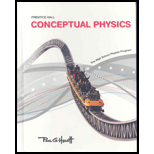
a. How fast would a particle have to be ejected from the sun to leave the solar system?
b. What speed would be needed if an ejected particle started at a distance from the sun equal to Earth’s distance from the sun?
(a)
The speed of a particle for the given condition.
Answer to Problem 16A
Explanation of Solution
Given:
A particle is ejected from the sun to leave the solar system.
Formula used:
According to the energy conservation principle, the total energy of an isolated system remains constant, neither it can be created nor can be destroyed.
The total energy is equal to the sum of potential energy
Calculation:
The escape velocity
Using the energy conservation principle, total energy initial and finally must be constant. Final velocity after escaping the gravity is zero since all the thrust is applied to work against gravity. And, the gravitational potential energy after escaping the star’s gravity is zero at infinite distance
Thus,
Escape velocity after substituting the values of constant of gravitation, mass of Sun, and radius of Sun is
Conclusion:
Thus, speed needed to escape the solar system from the Sun’s gravity is
(b)
The speed of a particle for the given condition.
Answer to Problem 16A
Explanation of Solution
Given:
A particle is ejected at a distance from the Sun which is equal to the distance of Earth from Sun.
Formula used:
Using the energy conservation principle, total energy initial and finally must be constant. Final velocity after escaping the gravity is zero since all the thrust is applied to work against gravity. And, the gravitational potential energy after escaping the star’s gravity is zero at infinite distance
Thus,
Calculation:
Escape velocity after inserting the values of constant of gravitation, mass of Earth and distance from the Sun equal to Earth’s distance from the sun is
Conclusion:
Thus, speed needed by an ejected particle at a distance from the Sun equal to Earth’s distance from the sun to escape the solar system is
Chapter 14 Solutions
Conceptual Physics: The High School Physics Program
Additional Science Textbook Solutions
Physics for Scientists and Engineers: A Strategic Approach, Vol. 1 (Chs 1-21) (4th Edition)
Lecture- Tutorials for Introductory Astronomy
Tutorials in Introductory Physics
University Physics with Modern Physics (14th Edition)
Applied Physics (11th Edition)
 College PhysicsPhysicsISBN:9781305952300Author:Raymond A. Serway, Chris VuillePublisher:Cengage Learning
College PhysicsPhysicsISBN:9781305952300Author:Raymond A. Serway, Chris VuillePublisher:Cengage Learning University Physics (14th Edition)PhysicsISBN:9780133969290Author:Hugh D. Young, Roger A. FreedmanPublisher:PEARSON
University Physics (14th Edition)PhysicsISBN:9780133969290Author:Hugh D. Young, Roger A. FreedmanPublisher:PEARSON Introduction To Quantum MechanicsPhysicsISBN:9781107189638Author:Griffiths, David J., Schroeter, Darrell F.Publisher:Cambridge University Press
Introduction To Quantum MechanicsPhysicsISBN:9781107189638Author:Griffiths, David J., Schroeter, Darrell F.Publisher:Cambridge University Press Physics for Scientists and EngineersPhysicsISBN:9781337553278Author:Raymond A. Serway, John W. JewettPublisher:Cengage Learning
Physics for Scientists and EngineersPhysicsISBN:9781337553278Author:Raymond A. Serway, John W. JewettPublisher:Cengage Learning Lecture- Tutorials for Introductory AstronomyPhysicsISBN:9780321820464Author:Edward E. Prather, Tim P. Slater, Jeff P. Adams, Gina BrissendenPublisher:Addison-Wesley
Lecture- Tutorials for Introductory AstronomyPhysicsISBN:9780321820464Author:Edward E. Prather, Tim P. Slater, Jeff P. Adams, Gina BrissendenPublisher:Addison-Wesley College Physics: A Strategic Approach (4th Editio...PhysicsISBN:9780134609034Author:Randall D. Knight (Professor Emeritus), Brian Jones, Stuart FieldPublisher:PEARSON
College Physics: A Strategic Approach (4th Editio...PhysicsISBN:9780134609034Author:Randall D. Knight (Professor Emeritus), Brian Jones, Stuart FieldPublisher:PEARSON





